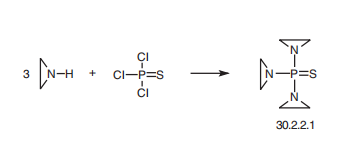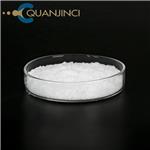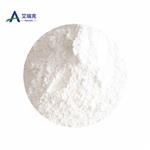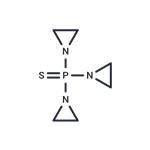Thiotepa, a tertiary aziridine, is less reactive than quaternary aziridinium compounds and is classified as a weak alkylator. It is possible for the nitrogen atoms to be protonate before reacting with DNA (a positively charged aziridine is more reactive than the un-ionized aziridine), but the electron-withdrawing effect of the sulfur atom decreases the pKa to approximately six, which keeps the percentage ionized at pH 7.4 relatively low. Thiotepa undergoes oxidative desulfuration, forming an active cytotoxic metabolite known as TEPA (triethylenephosphoramide).
Thiotepa is a crystalline substance.
Thio-Tepa,Lederle,US,1959
antiseborrheic, antipruritic
This substance is listed as a known human carcinogen. It is useful for the treatment of cancers, especially cancers resistant to chemotherapy. Antineoplastic.
Tri(1-aziridinyl)phosphine sulfide is useful for the treatment of cancers, especially cancers resistant to chemotherapy. Antineoplastic. Thio-TEPA (N,N?N?-triethylenethiophosphoramide) is used as a cancer chemotherapeutic, alkylating agent. It is used to treat various kinds of cancer such as breast, ovarian and bladder cancer. It is also used as conditioning treatment prior to hematopoietic progenitor cell transplantation (HPCT)
Although thiotepa is chemically less reactive than the nitrogen
mustards, it is thought to act by similar mechanisms.
Its oral absorption is erratic. After intravenous injection,
the plasma half-life is less than 2 hours. Urinary
excretion accounts for 60 to 80% of eliminated drug.
Thiotepa has antitumor activity against ovarian and
breast cancers and lymphomas. However, it has been
largely supplanted by cyclophosphamide and other nitrogen
mustards for treatment of these diseases. It is
used by direct instillation into the bladder for multifocal
local bladder carcinoma.
Nausea and myelosuppression are the major toxicities
of thiotepa. It is not a local vesicant and has been
safely injected intramuscularly and even intrathecally.
ChEBI: Thiotepa is a member of aziridines.
A solution of 30.3 parts of triethylamine and 12.9 parts of ethylenimine in 180
parts of dry benzene is treated with a solution of 16.9 parts of thiophosphoryl
chloride in 90 parts of dry benzene at 5°C to 10°C. Triethylamine
hydrochloride is filtered off. The benzene solvent is distilled from the filtrate
under reduced pressure and the resulting crude product is recrystallized from
petroleum ether. The N,N',N''-triethylenethiophosphoramide had a melting
point of 51.5°C.
The early success of the nitrogen mustards led researchers toinvestigate other compounds that contained a preformed aziridinering, and thiotepa resulted from this work. Thiotepa containingthe thiophosphoramide functionality was found to bemore stable than the oxa-analog (TEPA) but is metabolicallyconverted to TEPA by desulfuration in vivo.Thiotepa incorporatesa less reactive aziridine ring compared with thatformed in mechlorethamine. The adjacent thiophosphoryl iselectron withdrawing and, therefore, reduces the reactivity ofthe aziridine ring system. Although thiotepa is less reactivethan many other alkylating agents, it has been shown to formcross-links.
Odorless white crystalline solid.
Triethylenethiophosphoramide polymerizes readily upon exposure to heat or moisture, especially at acidic pH.
Flash point data for Triethylenethiophosphoramide are not available. Triethylenethiophosphoramide is probably combustible.
The unstable nitrogen-carbon groups alkylate with DNA which causes irreversible DNA damage. They stop tumor growth by crosslinking guanine nucleobases in DNA double-helix strands, directly attacking DNA. The DNA strands are unable to uncoil and separate which halts cell division.
Thiotepa and the TEPA metabolite readily enter the CNS after systemic administration, leading to dizziness, blurred vision, and headaches. More critically, these agents also are severe myelosuppressants and can induce leukopenia, thrombocytopenia, and anemia. Patients treated with thiotepa are at high risk for infection and hemorrhage.
This antineoplastic agent is most commonly employed in the treatment of ovarian and breast cancers, as well as papillary carcinoma of the bladder.
Patients have died from myelosuppression after intravesically administered thiotepa. The drug also causes damage to the hepatic and renal systems. Dose and/or administration frequency should be increased slowly, even if the initial response to the drug is sluggish, or unacceptable toxicity may result.
Confirmed human
carcinogen producing leukemia. Poison by
ingestion, intraperitoneal, intravenous, and
subcutaneous routes. Experimental
teratogenic data. Human systemic effects by
parenteral route: paresthesia, bone marrow
changes, and leukemia. Experimental
reproductive effects. Human mutation data
reported. When heated to decomposition it
emits very toxic fumes of POx, SOx, and
NOx.
Thiotepa, tris(1-aziridinyl)phosphine sulfate (30.2.2.1), is made by reacting
ethylenimine with phosphorous sulfochloride .

Used in the treatment of cancers resistant to chemotherapy. Antineoplastic: thiotepa has been prescribed for a wide variety of neoplastic diseases: adenocarcinomas of the breast and the ovary; superficial carcinoma of the urinary bladder; controlling intracavitary or localized neoplastic disease; lymphomas, such aslymphosarcomas and Hodgkin’s disease; as well as bronchogenic carcinoma.
Potentially hazardous interactions with other drugs
Antipsychotics: avoid concomitant use with clozapine.
Avoid concomitant use with other myelosuppressive agents. Administration
Thiotepa is known to be a human carcinogen based on sufficient evidence from studies in humans. Thiotepa was first listed in the Second Annual Report on Carcinogens in 1981 as reasonably anticipated to be a human carcinogen based on sufficient evidence of carcinogenicity from studies in experimental animals and insufficient evidenceof carcinogenicity from studies in humans. Thiotepa was reclassified as known to be a human carcinogen in the Eighth Report on Carcinogens in 1998.
Thiotepa is extensively metabolised to triethylenephosphoramide (TEPA), the primary metabolite, and some of the other metabolites have cytotoxic activity and are eliminated more slowly than the parent compound. It is excreted in the urine: less than 2
% of a dose is reported to be present as unchanged drug or its primary metabolite.
UN2811 Toxic solids, organic, n.o.s., Hazard Class: 6.1; Labels: 6.1-Poisonous materials, Technical Name Required. UN3249 Medicine, solid, toxic, n.o.s., Hazard Class: 6.1; Labels: 6.1-Poisonous materials.
One of the principal bond disruptions is initiated by alkylation
of guanine at the N-7 position, which severs the linkage
between the purine base and the sugar and liberates alkylated
guanines. This causes DNA cross-linking and prevents the
replication of rapidly dividing cells.
Tris(aziridinyl)phosphine sulfide polymerizes readily upon exposure to heat or moisture, especially at acidic pH. Incompatible with strong oxidizers (chlorates, nitrates, peroxides, permanganates, perchlorates, chlorine, bromine, fluorine, etc.); contact may cause fires or explosions. Keep away from alkaline materials, strong bases, strong acids, oxoacids, epoxides.
It is inappropriate and possibly dangerous to the environment to dispose of expired or waste pharmaceuticals by flushing them down the toilet or discarding them to the trash. Household quantities of expired or waste pharmaceuticals may be mixed with wet cat litter or coffee grounds, double-bagged in plastic, discard in trash. Larger quantities shall carefully take into consideration applicable DEA, EPA, and FDA regulations. If possible return the pharmaceutical to the manufacturer for proper disposal being careful to properly label and securely package the material. Alternatively, the waste pharmaceutical shall be labeled, securely packaged and transported by a state licensed medical waste contractor to dispose by burial in a licensed hazardous or toxic waste landfill or incinerator.




